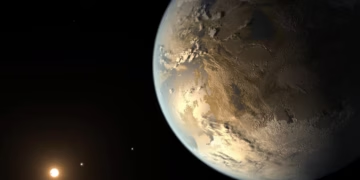Astronomers have unveiled a groundbreaking discovery in the search for alien worlds, as NASA’s Transiting Exoplanet Survey Satellite (TESS) has confirmed two Earth-sized planets orbiting a nearby star known as HD 101581.
A Remarkable Discovery: HD 101581 b and c
Two exoplanets, designated HD 101581 b and HD 101581 c, were detected orbiting a nearby star using data from TESS, followed by ground-based observations. These planets are slightly smaller than Earth, making them unique additions to the growing catalog of exoplanets.
HD 101581 b, the closer of the two planets, has a radius of 0.956 Earth radii and completes an orbit around its star in just 4.47 days. Its calculated equilibrium temperature is a scorching 834 K (561°C), indicating its close proximity to the star. HD 101581 c, slightly larger at 0.99 Earth radii, has a longer orbital period of 6.21 days and an equilibrium temperature of 747 K (474°C).
These findings suggest that both planets are far too hot to host life as we know it. Evidence for a potential third planet, which would have a radius of about 0.98 Earth radii and an orbital period of 7.87 days, adds another layer of intrigue to this system. If confirmed, this would position HD 101581 as a host to multiple Earth-sized worlds, a rare occurrence among known planetary systems.
The Host Star: HD 101581
At the heart of this discovery is HD 101581, a K-dwarf star located just 41.7 light-years away from Earth. This star, with a radius of 0.63 times that of the Sun and a mass of approximately 0.74 solar masses, represents an ideal target for exoplanetary studies.
Its brightness and proximity enable precise observations of its planets’ transit signals. HD 101581’s age, estimated at 7 billion years, combined with its cooler temperature of 4,634 K, suggests a stable environment where planetary systems can form and evolve. The discovery of multiple Earth-sized planets around such a star provides valuable insights into the dynamics and formation processes of compact planetary systems.
The Science Behind the Discovery
The detection of HD 101581 b and c was made possible through the combined efforts of TESS and ground-based telescopes. TESS, launched in 2018, surveys the brightest stars near the Sun to detect dips in their brightness caused by planets transiting across their surfaces. For HD 101581, these transit signals were identified in data from TESS sectors 63 and 64.
Follow-Up Observations
Ground-based telescopes were used to confirm the planetary nature of the transit signals. These observations provided critical data on the planets’ masses, radii, and orbital periods. Together, these findings paint a detailed picture of the HD 101581 system.
Advanced Techniques
State-of-the-art techniques, such as light curve analysis, allowed astronomers to detect the subtle signals of these small planets. This achievement highlights the growing precision of exoplanet detection methods and their ability to uncover worlds that were previously beyond our reach.
Future Directions in Exoplanet Research
The HD 101581 system opens the door to exciting possibilities for future research. Scientists are eager to explore these planets in greater detail, particularly their atmospheres and compositions.
1. Atmospheric Studies with JWST
The James Webb Space Telescope could be used to search for atmospheric signatures on these planets. By analyzing their spectra during transits, astronomers can identify gases and other compounds in their atmospheres, providing clues about their formation and evolution.
2. Confirmation of the Third Planet
The suspected third planet in the system, if confirmed, would further enhance the significance of this discovery. Understanding its properties could reveal new insights into the architecture of compact planetary systems.
3. Broader Implications
Studying HD 101581 and its planets contributes to the larger effort to map the diversity of planetary systems in our galaxy. Comparing these findings with other systems could reveal patterns and anomalies that deepen our understanding of planetary formation.
What We Learn from HD 101581
This discovery reinforces the idea that planetary systems can take on a wide variety of forms. While HD 101581’s planets are unlikely to host life, they provide valuable data about the range of conditions under which planets can form and persist.
By studying these extreme environments, scientists can refine their models and predictions for other planetary systems, including those that may harbor life. Moreover, the proximity and brightness of HD 101581 make it an invaluable target for continued study. As telescopes become more powerful, our ability to analyze such systems will only improve, leading to new breakthroughs and discoveries.
Conclusion
The discovery of two Earth-sized exoplanets orbiting HD 101581 represents a major milestone in exoplanet research. These planets, among the smallest yet found around a nearby star, offer a unique opportunity to study the dynamics and characteristics of compact planetary systems.
Reference:



















